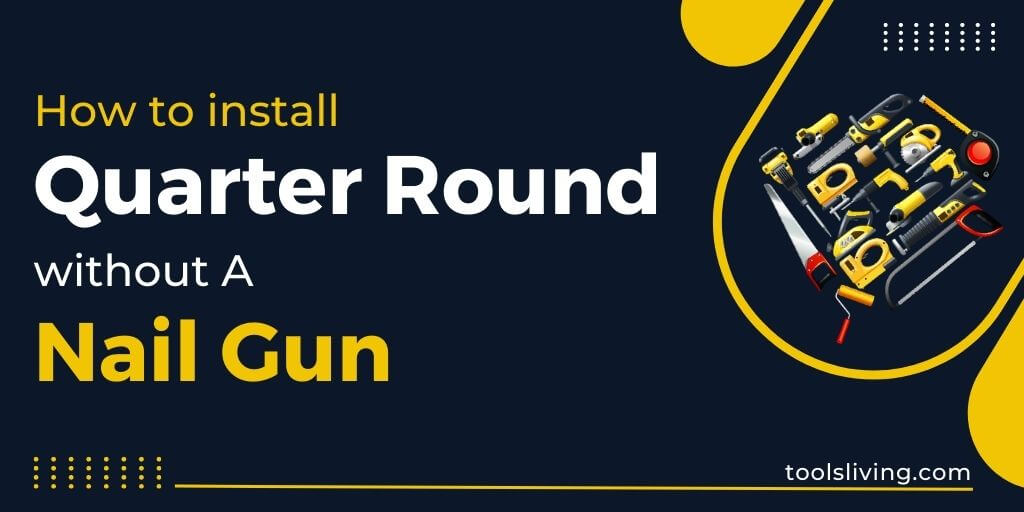It doesn’t matter if you just installed new floors or refurbished or trimmed them. During the line, you will still have to install new moldings.
In this article, I will walk you through the best way on how to install a quarter round without a nail gun but with other simple tools.
Quarter round is an ideal and perfect option that you can employ when it comes to your floors and walls, plus it gives them a clean and finished look.
Most tutorials you will find online place their core focus on installing quarter rounds using a pneumatic nail gun.
Nevertheless, the challenge is that these nail guns are usually expensive and also not readily available for rent.
Besides that, DIYers like you and I don’t have to invest in a nail gun we will barely use.
You don’t have to be on that corner, which is why this article is a step-by-step guide on how to install quarter-round molding on the floor using a hammer and nails.
But that’s the first part. We will also walk you through an alternative, which is how you can install quarter-round molding on the floor using construction adhesive.
Let’s get started!
Tools You Will Need to Install Quarter Round Molding
- Hammer
- Nail Set
- Finishing nails
- Latex sealant
Contents
How to install quarter round molding without a nail gun (hammer & nails)
A nail set looks more like a pencil, being a simple tool made out of metal, instead of using conventional nails to do the finishing.
It’s preferable to use a nail set so that you’ll get a clean finish around the molding.
Step 1: Cut Molding
Now to cut the molding, you’ll need a saw. You can use any saw that works well for you to cut quarters round molding.
For example, I prefer to use a hand saw since it’s relatively easier to cut by hand.
Step 2: Lay the Molding Flat Against the Wall
There is no cause for alarm if you have small gaps between the floor molding and the wall.
The reason is that you can quickly fill those gaps later using latex sealant. What you need to pay more attention to is how the molding lays flat against the floor.
Step 3: Finishing Nail Should be Hammered Almost into the Wall
Don’t nail baseboards into the floor. They are to be nailed to the wall. It will be easier if you hammer at an angle slightly downward instead of attempting to nail it straight in.
Take extra caution while you hammer to prevent missing the baseboard, hence ending up hitting your finger. It comes with practice, but you will get the hang of it.
When the nail is about 1/8 inch into the wall, you have to stop hammering.
Step 4: Use your nail set to drive the rest of the nail into the quarter round
Before anything, you have to carefully line the nail set’s tip using the top of your nail.
Now, nail sets typically come in various sizes, but it is best to use one a bit thinner than your nailhead.
Then take your hammer and use it to drive the remaining part of the nail straight into the wall using the nail set.
You might miss this at first, but there is no need to fret it requires practice. If it makes more sense, you can practice using plain plywood so you get the hang of it.
Once you’ve driven the nail below the surface of the floor, then you’re more than halfway done with the task. Continue pushing the nails at least three feet from the length of the baseboard.
Step 5: Finish with Sealant
This part is straightforward. Take the sealant tube you’ve bought from your local retail shop and apply it to the gap between the quarter-round molding and the wall.
If you don’t want to use a sealant, an alternative you can use is caulk.
Sometimes when you’re applying the sealant, it may come out of the tube quite sloppy, don’t worry, it’s no cause for alarm. If you want a smooth and perfect seal, let your finger do the job.
Use your finger to rub through the top of the quarter round to smooth it out. If there is any excess sealant left on your finger, use a paper towel to wipe it off.
Step 6: Cover nail heads
One way to know if you’ve carried out a good job with the nailhead is that they will be barely noticeable.
But that’s not enough, because the goal is to have a clean job. So, you have to rub latex sealant over the molding to make it more invisible.
Nevertheless, if what you have is already messy, there is no need to fret. Sand it down immediately after the sealant dries out.
If you want the task to be effortless, we recommend using white sealant and white baseboard. The reason is that everything will blend just right in without any hassle.
But if what you’ve used is the normal, natural wood baseboards with that brown color, you can paint it so it will blend at the end.
How to install quarter round molding without a nail gun (using construction adhesive)
Another method you can use to bridge the gap between the quarter and the wall is to apply construction adhesive to glue the baseboard.
Step 1: Measure and cut the molding
You have to cut your quarter-round, ensuring that it suits the length of the baseboard. If possible, make the necessary angle joints.
Step 2: Prepare the quarter round.
With the help of sandpaper, scuff the sides of the quarter round against the baseboard. You should at least make five strokes while doing this.
Repeat the same procedure on the baseboard rather than the sides for the quarter round. If you do this appropriately, you should have enhanced the bond between the two pieces.
Step 3: Apply adhesive
Now, when applying the adhesive, be careful not to spill it over the rough side of your quarter round.
Remember, the aim is to have clean work. So, carefully apply the adhesive around the quarter round.
Step 4: Attach the quarter round
Attach the quarter round by pressing it tightly against the wood and the baseboard. Keep that hold for about 3 minutes so that both materials will bond tightly.
Step 5: Clear out any mess
Use a piece of damp cloth or perhaps a sponge to wipe off the adhesive that is still visible on the baseboard seam and quarter-round.
Step 6: Repeat the step for other quarter rounds
Follow the same procedure for other quarter rounds and baseboards using the remaining construction adhesive.
Voila! Nice, clean-looking baseboards.
Final Verdict
Overall, if you’re not a professional carpenter like me, you don’t have to invest in a nail gun you’ll barely ever use.
Follow the step-by-step guide laid out here on how to install a quarter round without a nail gun, and you’re good to go. No hassle!
Frequently Asked Question (FAQ)
Can I install quarter round without a nail gun?
If you’ve just gone through the article’s guide, then it’s obvious that the answer is a solid yes.
You can use different options to install quarter-round, other than the conventional nail gun.
You can use a hammer and nails, or if that doesn’t suit you, it is possible to also use construction adhesive.
But, whichever method you decided to implore, always remember that the aim is to have a clean job.
Should you glue or nail quarter round?
Quarter rounds can be nailed, but still, there can also be glued. It all just boils down to what method you know how to use.
Can I glue my baseboard instead of nailing?
Yes! You can glue your baseboard instead of investing in a nail gun that you’ll barely use or using regular nails.
But, when gluing, it is recommended that you use construction adhesives and not regular glue.
How much does it cost to have a quarter-round install?
If you prefer to hire the service of a professional rather than installing the quarter-round molding yourself, the service charge is typically $300-$350 for a 20X20 room.
Other professionals usually charge $2.65-$4.90 per linear foot. Nevertheless, it all depends on the service charge around the location you reside.

